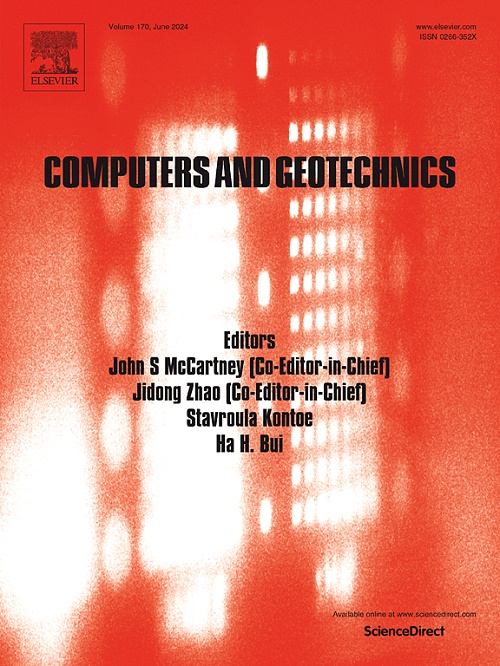Study on the influence of 3D pre-existing joint on rockfall fragmentation during impact based on discrete element method
IF 5.3
1区 工程技术
Q1 COMPUTER SCIENCE, INTERDISCIPLINARY APPLICATIONS
引用次数: 0
Abstract
Rockfalls pose significant threats to human society as one of the three major geological hazards. Numerous joints developed internally during their geological formation, leading to their fragmentation in motion and affecting trajectory and accumulation range, thereby increasing the hazard uncertainty. There are few studies on the fragmentation of jointed rockfalls, and only some focus on the influence of terrain, impact angle, and material properties on rockfall failure with continuous mechanics and extended finite element methods. However, very few analyses of the fragmentation mechanism of 3D jointed rockfall are from the perspective of discontinuous medium mechanics. Based on the indoor experiments to acquire the calculation parameters and consider the fracture character, we use the Discrete Element Method (DEM) to establish an impact model of rockfall with pre-existing joints to address these. We conduct numerical impact tests on samples containing joints of varying lengths, inclinations, thicknesses, and positions. By proposing the volume fragmentation ratio and number of main fragments and calculating them, monitoring changes in crack propagation events, acoustic emission events, impact force, and energy, the study investigates the specific effects of joints on the impact fragmentation of samples. The results indicate that the Discrete Element Method with parameters corrected by fracture tests can realistically simulate the three-dimensional fragmentation of jointed rockfall under actual conditions, solving the problem of stress concentration at the crack tip in Finite Element analyses. The geometric parameters and spatial position of the pre-existing joint largely determine the fragmentation of rockfall and the shape of blocks after disintegration, significantly impacting the impact force and the kinetic energy of the bouncing stone. Among them, joint inclination and length greatly influence the overall fragmentation of rockfall. In contrast, the position of a side or centered joint notably influences the micro-cracks and local damage on the contact area of rockfall, and joint thickness close to the maximum radium of calculation particle affects fragmentation significantly.
基于离散元法的三维预存节理对冲击过程中岩崩破碎影响研究
作为三大地质灾害之一,落石对人类社会构成了重大威胁。在其地质形成过程中,内部发育了许多节理,导致其在运动中破碎,影响运动轨迹和堆积范围,从而增加了危害的不确定性。关于节理岩崩破碎的研究很少,只有一些研究侧重于地形、冲击角度和材料特性对岩崩破坏的影响,并采用了连续介质力学和扩展有限元方法。然而,从非连续介质力学角度分析三维节理落石破碎机理的研究却寥寥无几。为了解决这些问题,我们在室内试验获取计算参数和考虑断裂特征的基础上,采用离散元法(DEM)建立了带有预存节理的落石冲击模型。我们对包含不同长度、倾斜度、厚度和位置的节理的样本进行了数值冲击试验。通过提出体积碎裂率和主要碎裂物数量并对其进行计算,监测裂缝扩展事件、声发射事件、冲击力和能量的变化,研究了节理对样本冲击碎裂的具体影响。结果表明,通过断裂试验修正参数的离散元素法能够真实模拟实际条件下节理落石的三维破碎,解决了有限元分析中裂缝尖端应力集中的问题。预留节理的几何参数和空间位置在很大程度上决定了落石的破碎程度和解体后的块体形状,对冲击力和反弹石块的动能有显著影响。其中,节理的倾斜度和长度对落石的整体破碎程度影响很大。相比之下,侧向或中心节理的位置对落石接触区的微裂缝和局部破坏有明显影响,而节理厚度接近计算颗粒的最大镭射度对碎裂有明显影响。
本文章由计算机程序翻译,如有差异,请以英文原文为准。
求助全文
约1分钟内获得全文
求助全文
来源期刊

Computers and Geotechnics
地学-地球科学综合
CiteScore
9.10
自引率
15.10%
发文量
438
审稿时长
45 days
期刊介绍:
The use of computers is firmly established in geotechnical engineering and continues to grow rapidly in both engineering practice and academe. The development of advanced numerical techniques and constitutive modeling, in conjunction with rapid developments in computer hardware, enables problems to be tackled that were unthinkable even a few years ago. Computers and Geotechnics provides an up-to-date reference for engineers and researchers engaged in computer aided analysis and research in geotechnical engineering. The journal is intended for an expeditious dissemination of advanced computer applications across a broad range of geotechnical topics. Contributions on advances in numerical algorithms, computer implementation of new constitutive models and probabilistic methods are especially encouraged.
 求助内容:
求助内容: 应助结果提醒方式:
应助结果提醒方式:


